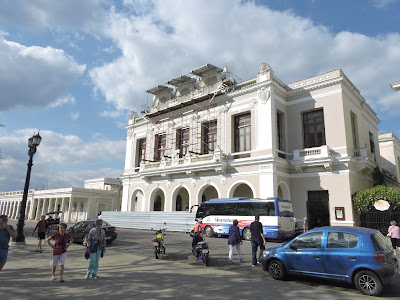We had our last sea day yesterday. We’ve got quite a streak
of trivia wins going, I think our team has won trivia 10 times now. Our
best ever! Our best subject is geography. One quiz was to identify 15 countries
by their shape. We completed 14 of 15 is about five minutes and then argued
about the last country. We learned that you could turn your paper in and if it
was wrong, you could try again. So we did, our best guess was Panama, and we
were right. A few days later, the quiz was to identify the 49 countries from a
map of the continent of Europe. We identified all 49 but got two countries in
the wrong order. No one else had over 30 countries identified. The other
highlight was our evening show, the
Barricade Boys. These 4 singers had met
doing Les Miserable on London’s West End. Their voices were powerful and
brought tears to my eyes. I’d gladly pay to see these guys again, and bought
their CD.
Today, we docked in
Havana harbor. Currently only one of the
three docks is active, so they can handle two ships. The other two are in total
disrepair, with a plan to eventually fix them. Our tour is a nine hour bus tour
of the city with a walking tour of old Havana at the end. Our first major stop
was Revolutionary Square with tributes to
Jose’ Marti', writer, poet, and
Politician who fought for Cuban Independence from Spain. Our guide explained that
in 1898, America joined the war against Spain with Cuba largely because of the
USS Maine blowing up in the harbor (which at the time was thought to be sabotage
but appears to more likely have been an accident). But Cuba didn’t get
independence, instead they became a protectorate of the U.S. (This is when we
got Guantanamo Bay Naval Station and the right to invade Cuba in the future).
Restrictions were put on Cuba to only trade with the U.S. Cuba went from one
colonial power to another.
 |
Revolutionary Square
|
Our next stop was the Christopher Columbus cemetery the
oldest (1871) Catholic Cemetery in Cuba. We found many interesting tombstones
to bar tenders (the creator of the daiquiri) , businessmen, and baseball
players as well as a monument for fire fighters.
As we went through the city, our guide impressed us with
what as really been good since the revolution as well as pointing out how
difficult life has been with the U.S. Embargo. A few highlights: The number one
export from Cuba is medical services: either students from other countries
studying medicine in Cuba or Cuban doctors and nurses going to other countries
to practice and sending money home. The second most important is tourism
(Canadians are their primary tourists). Cigars are fourth. Education is free through University. Before
the revolution, there were only three universities and most of the country was
illiterate, today education is free and compulsory through age 15.
 |
Lineup of Classic Cars
|
Cuba is known for its classic cars and they are beautiful,
most have been retrofitted with diesel engines to keep them running. Of course,
the U.S. embargo didn’t allow the U.S. to sell new cars here after the
revolution. But when Fidel took over, there was no way to sell a car in the
secondary market, so most of the cars, remained in the family for all these
years. Today, most of these cars serve as taxis for tourists. Transportation is
a huge problem for Cubans, there are not enough buses for the population and
taxis cost more than your daily wage.
 |
Famous guests at La Bodequita del Medio
|
We ate lunch at the
La Bodequita del Medio, a famous haunt
of Ernest Hemmingway and home of the Mojito, just off of Plaza de la Cathedral.
We had a nice sampler plate of Cuban dishes. The spices were interesting and
quite mild.
After lunch we had a chance to sample the 3 famous
commodities of Cuba: rum, coffee, and cigars. There are 27 different brands of
cigar produced in Cuba, we sampled Winston Churchill’s favorite: Romeo and
Juliet. Well, actually only 2 on our tour tried the cigar, the rest kept theirs
to take back to the U.S.
Our last bus stop was at
El Morro Castle. The large Spanish fort
that protects the entrance to the harbor. This stop ended up being
disappointing, it was primarily a shopping point to buy cigars, and we saw only
a little of the fort. As promised, we ended the day with about 10 of us walking
the old colonial city, seeing more of the key squares. Our guide seemed to get
more adamant about how great Cuba could be if the U.S. embargo would come to an
end. I’ll admit, it makes no sense why we’ve kept this embargo for 60 years,
when we’ve made up with Japan, Germany, and Vietnam, but we did get tired of
hearing the message. We were tired and happy to spend the evening on the ship,
rather than go out to see a show. But we heard good things the next day about
the show at the Tropicana Club.
 |
The Colonial City
|











